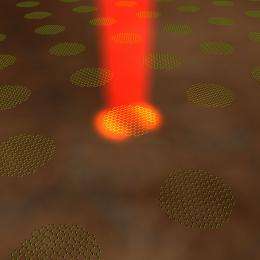February 1, 2012 report
Physics team calculates that graphene disks could be complete optical absorbers

(PhysOrg.com) -- In optical devices designed and used to collect light, there has always been a loss of light due to reflection, now, new research by a team of physicists from Spain and England has found, via calculation, that if charged graphene disks of just the right size were made and placed the right distance from one another, they should be able to achieve 100% light absorption. On the team were Sukosin Thongrattanasiri and Javier García de Abajo from Spain and Frank Koppens from the UK. Together they have published a paper in Physical Review Letters describing their research.
Taken alone, graphene (a layer of carbon just one atom thick) isn’t much good at absorbing light, with just a 2.3% absorption rate. But if it were made into very tiny dots or nanodisks the team suggests, plasmons could be exploited to increase the absorption rate. Plasmons are oscillations of electrons at the quantum level and interact with light because of the electrical field they generate. To cause these oscillations to occur in graphene, a small electrical charge could be applied and changing the amount of charge would change the amount of oscillation, which would mean the amount of light interaction could be modified by adjusting the amount of charge as well. Because of this, a mathematical formula can be used to describe just the right amount of charge needed to cause the oscillations to interact with all of the available light. As it turns out, the amount of charge needed to make that happen is the amount necessary to cause the frequency of the oscillations to match the frequency of the light. But, in order to create just the right electrical field, the graphene must be manipulated in such a way as to allow for fine control of the oscillations, and that’s where shaping them into disks comes in. Making them just the right size should in theory, allow researchers to create the optimum electrical field that would allow for 100% light absorption. Important also is the placement of the nanodisks in relation to one another. Too close and they will interfere with one another while too much distance would result in less than perfect light absorption due to an uneven electrical field.
The next step in this research effort will, of course, entail the creation of an actual physical material with nanodisks in it, to ensure the real world product matches the theory. If all works out as planned, new superefficient optical devices, such as spectrometers, could result.
More information: Complete Optical Absorption in Periodically Patterned Graphene, Phys. Rev. Lett. 108, 047401 (2012) DOI:10.1103/PhysRevLett.108.047401
Abstract
We demonstrate that 100% light absorption can take place in a single patterned sheet of doped graphene. General analysis shows that a planar array of small particles with losses exhibits full absorption under critical-coupling conditions provided the cross section of each individual particle is comparable to the area of the lattice unit cell. Specifically, arrays of doped graphene nanodisks display full absorption when supported on a substrate under total internal reflection and also when lying on a dielectric layer coating a metal. Our results are relevant for infrared light detectors and sources, which can be made tunable via electrostatic doping of graphene.
via Physics Focus
Journal information: Physical Review Letters
© 2011 PhysOrg.com


















